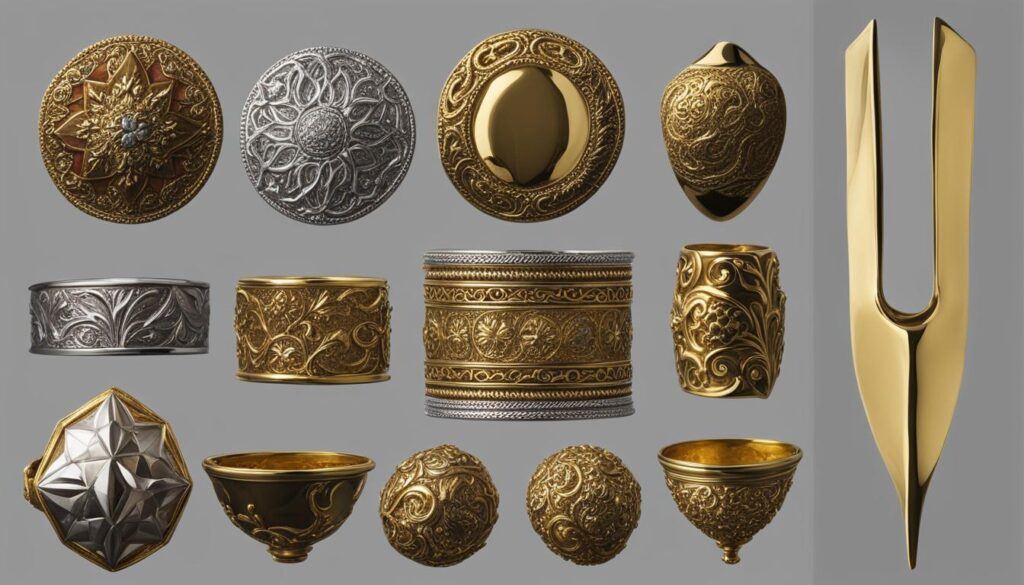When it comes to choosing jewelry, the metal used often plays a significant role. Two popular options for jewelry making are gold plated brass and sterling silver. Understanding the differences between the two can help you make an informed decision when selecting your next piece. Let’s explore the characteristics and qualities of gold plated brass and sterling silver.
Key Takeaways:
- Gold plated brass is a cost-effective option for mimicking the appearance of gold, but it may not be hypoallergenic and lacks long-term value.
- Sterling silver is a popular metal in jewelry making, known for its durability and higher value compared to brass.
- Both gold plated brass and sterling silver can be used as a base metal for gold plating.
- Consider factors such as your budget, desired appearance, and potential allergies when choosing between gold plated brass and sterling silver for your jewelry.
- Proper cleaning and maintenance are essential to preserve the beauty and longevity of plated jewelry.
Brass
Brass is an alloy made of zinc and copper and has been a staple in jewelry for its affordability and ability to mimic gold. It is commonly used in fashion or bridge jewelry due to its low price-point. While polished brass won’t tarnish, it may cause allergic reactions in individuals with sensitive skin. Brass also lacks long-term value and its color may change over time.
“Brass jewelry offers an attractive and budget-friendly option for those looking to enhance their style. Its golden appearance allows it to imitate the look of gold, making it a popular choice in the fashion world.” – Jewelry Expert
Despite its affordable price, brass jewelry has some limitations. The alloy can trigger allergic reactions in individuals with sensitive skin, making it unsuitable for those with metal allergies. Additionally, brass lacks the enduring value seen in precious metals like gold or sterling silver. Over time, the color of brass may change, requiring regular maintenance and care to preserve its original appearance.
Benefits of Gold Plated Brass
Gold plated brass combines the affordability of brass with the luxurious appearance of gold. This process involves applying a layer of gold over the brass base, creating a beautiful golden finish that closely resembles solid gold.
The benefits of gold plated brass include:
- Economic Choice: Gold plated brass provides an affordable alternative to solid gold jewelry, allowing individuals to enjoy the elegant look of gold without the higher price tag.
- Versatility: Gold plated brass jewelry can be designed to suit a wide range of styles, making it a versatile option for various fashion preferences.
- Durability: The brass base provides strength and durability to gold plated jewelry, ensuring its longevity and resistance to wear and tear.
- Easy Maintenance: Gold plated brass jewelry is relatively easy to maintain. Regular cleaning with a mild soap and water solution can help keep its lustrous shine intact.
If you’re looking to incorporate the allure of gold into your jewelry collection without breaking the bank, gold plated brass is a fashionable and budget-friendly choice.
| Brass Jewelry | Benefits |
|---|---|
| Mimics the appearance of gold | Offers an affordable option for gold-like jewelry |
| Flexible design potential | Suits a variety of style preferences |
| Durable and long-lasting | Resistant to everyday wear and tear |
| Low maintenance | Easy to clean and care for |
Sterling Silver
Sterling silver is a highly sought-after metal in the world of jewelry making. Its versatility, durability, and inherent beauty make it an excellent choice for crafting stunning pieces. Whether worn on its own or used as a base metal for gold plating, sterling silver jewelry offers numerous benefits.
High Quality and Value
Sterling silver is considered a precious metal, highly valued for its purity and composition. Made up of 92.5% silver and 7.5% other metals, usually copper, sterling silver combines the best qualities of both metals. This unique composition adds strength, durability, and resistance to the jewelry piece, ensuring longevity and maintaining its shape over time.
Compared to alloys like brass, sterling silver holds higher value in the market and is often regarded as an investment. Its intrinsic value combined with its aesthetic appeal makes sterling silver jewelry a popular choice among consumers.
Durability and Tarnish Resistance
Sterling silver is known for its durability, making it suitable for everyday wear. It is a sturdy metal that can endure the rigors of daily activities without losing its shape or integrity. This durability allows sterling silver jewelry to last for generations, becoming heirloom pieces that can be passed down through the family.
One of the significant advantages of sterling silver is its resistance to tarnish. While pure silver may tarnish easily, the addition of copper in sterling silver prevents tarnishing and keeps the jewelry looking radiant for an extended period. Routine cleaning and maintenance can further enhance the longevity and beauty of sterling silver jewelry.
Affordable Luxury
While gold holds a prominent position in the world of luxury jewelry, it comes with a higher price tag. Sterling silver offers an affordable alternative that exudes elegance and sophistication. Its lustrous surface and reflective qualities give sterling silver jewelry a luxurious appearance, making it an attractive choice for those seeking high-quality jewelry without breaking the bank.
Whether you’re looking for a statement necklace, a pair of delicate earrings, or a classic sterling silver ring, this metal offers an extensive range of design possibilities. It can be adorned with gemstones, engraved, or embellished to create unique and personalized pieces that cater to individual tastes and styles.
Gold Plated vs. Sterling Silver
| Gold Plated | Sterling Silver |
|---|---|
| Base Metal | Potential base metal for gold plating |
| Lower cost | Higher value and composed of a precious metal |
| May cause allergic reactions | Durable and hypoallergenic |
| Less long-term value | Considered an investment and holds value |
| Appearance mimics gold | Unique radiance and shine |
| Requires occasional re-plating | Resistant to tarnish and maintains its beauty with routine care |
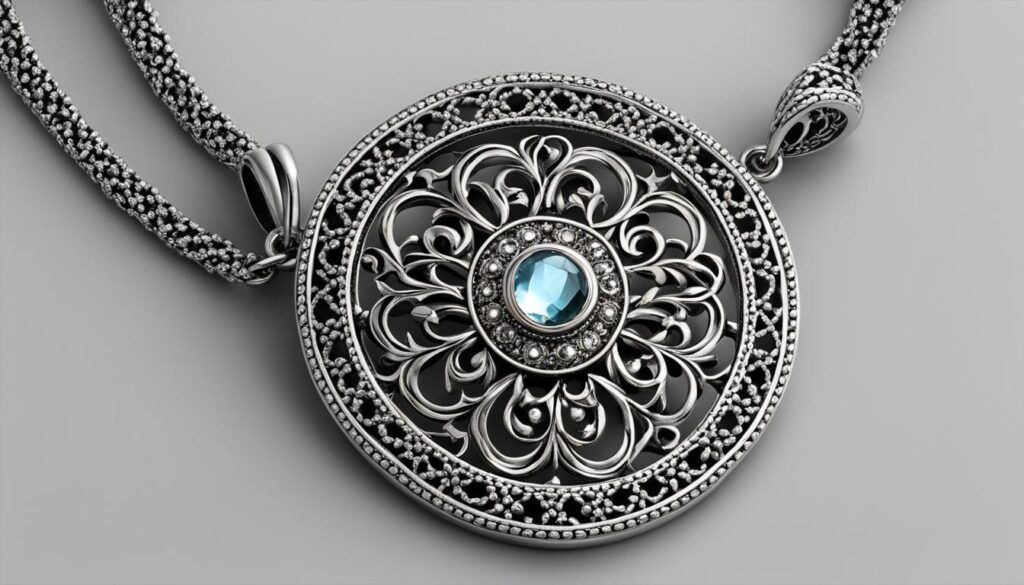
When comparing gold plated jewelry to sterling silver, it’s important to consider factors such as base metal, durability, value, and appearance. Gold plated jewelry, with its lower cost and gold-like appearance, can be an attractive option. However, it may cause allergic reactions and lacks the long-term value and durability of sterling silver. Sterling silver, on the other hand, offers the best of both worlds – it serves as a base metal for gold plating while providing the inherent qualities of a precious metal. Additionally, sterling silver is resistant to tarnish, making it more convenient for everyday wear.
Gold
Gold has long been revered and coveted in the world of jewelry. Its timeless beauty and enduring value make it a prized choice for fine jewelry pieces. The versatility of gold is showcased through its various colors, including yellow, white, and rose, allowing for a wide range of design possibilities.
When it comes to durability, gold is an excellent choice. Unlike other metals, gold does not rust, tarnish, or corrode, making it a reliable option for everyday wear. This durability ensures that your gold jewelry will maintain its stunning appearance for years to come.
Colors of Gold
One of the distinguishing features of gold is its range of colors. Each color is achieved by mixing gold with different metals. The most common colors of gold used in jewelry are:
- Yellow Gold: This classic and warm hue is the natural color of pure gold, blended with alloys such as copper and zinc.
- White Gold: Achieved by combining gold with white metals like palladium or nickel, white gold has a sleek and modern appearance.
- Rose Gold: Its romantic and feminine look is created by adding copper to gold, resulting in a delicate pinkish hue.
Investment Value
Gold is not only cherished for its aesthetics but also for its investment value. As a precious metal, gold has historically retained its worth, making it an attractive option for those looking to invest in jewelry. Its value can fluctuate based on market demand and economic conditions, making gold jewelry a potential asset.
Gold Plated Jewelry
Gold plated jewelry offers an attractive and affordable option for those who desire the luxurious appearance of gold without the hefty price tag. This type of jewelry involves applying a layer of gold onto a base metal, such as brass or sterling silver, through a process known as gold plating.
The gold plating process begins by thoroughly cleaning the base metal to ensure a smooth surface for the gold layer to adhere to. The metal is then immersed in a bath containing a solution of gold ions, which are attracted to the metal and bond with its surface. Next, an electric current is applied, causing the gold ions to form a thin layer of gold over the metal.
The thickness and carat of the gold plating can vary, impacting the color and quality of the piece. A higher carat gold plating, such as 18K or 24K, will produce a richer and more genuine gold color. Thicker layers of gold plating generally result in a longer-lasting finish.
Gold plated jewelry offers the opportunity to enjoy the beauty and elegance of gold at a fraction of the cost. However, it is important to note that the gold plating layer may wear off over time, especially with frequent use or exposure to chemicals and moisture. To maintain the appearance of gold plated jewelry, it is recommended to avoid swimming, showering, or applying perfumes and lotions while wearing it. Regular cleaning with a soft cloth and mild soap can help remove dirt and restore its shine.
Gold plated jewelry provides a versatile option for accessorizing various outfits and occasions. It can be found in a wide range of designs, from delicate necklaces and earrings to statement rings and bracelets. Whether you’re looking for a classic piece or a trendy fashion accessory, gold plated jewelry allows you to express your personal style without breaking the bank.
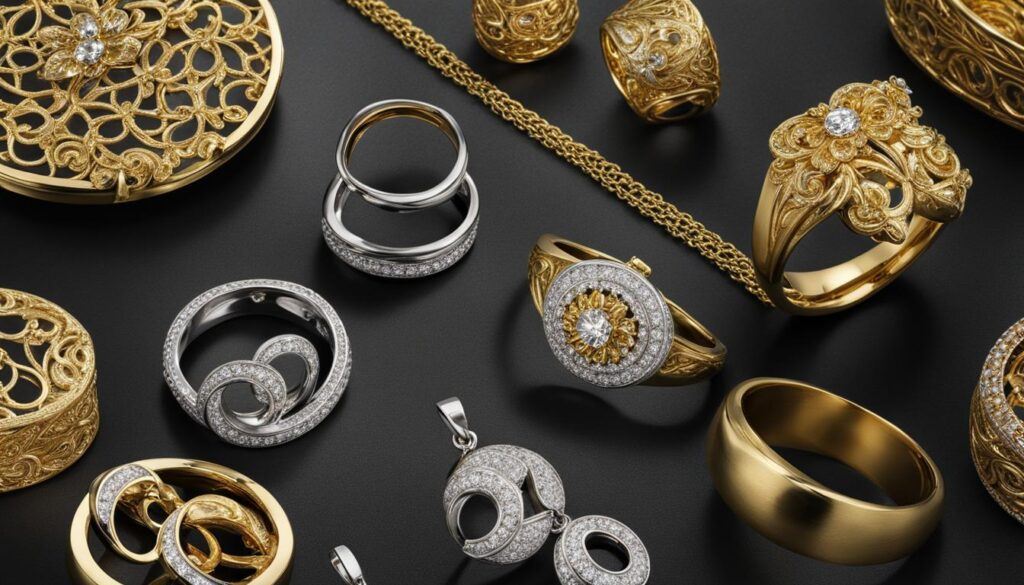
Silver Plated Jewelry
Silver plated jewelry offers an attractive and cost-effective alternative to solid silver pieces. It involves coating a base metal, such as copper or brass, with a thin layer of silver. This layer gives the jewelry the appearance of solid silver, allowing you to enjoy the aesthetic without the higher price tag.
One of the advantages of silver plated jewelry is its versatility. The thickness of the silver layer and the base metal used can vary, allowing for a range of designs and styles. Whether you prefer delicate and dainty pieces or bold and statement-making jewelry, there’s a silver plated option to suit your taste.
It’s important to note that silver plated jewelry requires regular maintenance to prevent tarnishing. Over time, the silver layer may wear off or become discolored. To keep your silver plated jewelry looking its best, it’s recommended to clean it gently with a silver polishing cloth or a mild silver cleaner. This helps to remove any tarnish and restore the shine of the silver layer.
When caring for your silver plated jewelry, avoid using harsh chemicals or abrasive materials, as these can damage the plating. Additionally, it’s advisable to remove silver plated jewelry before engaging in activities that may expose it to excessive moisture, such as swimming or showering.
Overall, silver plated jewelry offers a stylish and affordable option for those who appreciate the beauty of silver. By understanding the silver plating process and taking proper care of your jewelry, you can enjoy the elegance and charm of silver at a fraction of the cost.
| Pros of Silver Plated Jewelry | Cons of Silver Plated Jewelry |
|---|---|
| 1. Affordable alternative to solid silver. | 1. Requires regular maintenance to prevent tarnishing. |
| 2. Versatile designs and styles. | 2. The silver layer may wear off or discolor over time. |
| 3. Gives the appearance of solid silver. | 3. Avoid using harsh chemicals or abrasive materials when cleaning. |
Rhodium Plated Jewelry
When it comes to enhancing the luster and shine of jewelry while providing excellent protection against tarnishing and scratches, rhodium plated jewelry is a top choice. This type of jewelry is coated with a layer of rhodium, which is a rare and reflective metal.
Rhodium plating is commonly used on sterling silver jewelry, adding a touch of luxury and elegance to the pieces. The process involves depositing a thin layer of rhodium onto the surface of the jewelry through electroplating.
One of the main benefits of rhodium plating is its exceptional durability. The layer of rhodium creates a strong barrier that shields the underlying metal from the effects of daily wear and tear.
In addition to durability, rhodium plated jewelry is hypoallergenic, making it an excellent choice for individuals with sensitive skin. The rhodium layer acts as a protective barrier between the skin and the base metal, reducing the risk of allergic reactions.
Furthermore, rhodium plating requires less maintenance compared to other types of plated jewelry. The reflective properties of rhodium help to keep the jewelry looking bright and shiny for longer periods, requiring minimal polishing or cleaning.
“Rhodium plated jewelry adds a brilliant sparkle to any ensemble while offering long-lasting beauty and protection.” – Expert Jeweler
Whether it’s a stunning necklace, an elegant ring, or a pair of dazzling earrings, rhodium plated jewelry is a popular choice for its aesthetic appeal and practical advantages. Its reflective surface catches the light beautifully, adding an extra touch of glamour to any outfit.
Rhodium Plated Jewelry
| Advantages of Rhodium Plating | Disadvantages of Rhodium Plating |
|---|---|
| Enhances luster and shine | Requires re-plating over time |
| Protects against tarnishing and scratches | Can be more expensive than other plating options |
| Durable and long-lasting | May have a slightly different appearance compared to other metals |
| Hypoallergenic | May take longer to repair or resize due to the delicate nature of the plating |
| Requires less maintenance and polishing |
Comparing Brass and Sterling Silver
When it comes to jewelry making, brass and sterling silver are two popular metals to consider. While they both have their unique qualities, understanding the differences between them can help you make an informed decision. Let’s explore the characteristics of brass and sterling silver and how they compare.
Brass
Brass is an alloy made of zinc and copper. It is known for its affordability and ability to mimic the appearance of gold through plating. Brass is commonly used in fashion or bridge jewelry due to its low price-point.
However, it is important to note that brass may not be hypoallergenic and can cause allergic reactions in individuals with sensitive skin. Additionally, while polished brass doesn’t tarnish easily, its color may change over time.
Sterling Silver
Sterling silver, on the other hand, is a popular metal in jewelry making and is often used as a base for gold plating. It is made up of 92.5% silver and 7.5% other metals, typically copper.
Sterling silver is valued for its durability, making it suitable for everyday wear. It is also resistant to tarnish and relatively affordable compared to gold. In the world of jewelry, sterling silver is considered a precious metal and holds more value than alloys like brass.
Comparing Brass and Sterling Silver
Here’s a table summarizing the key differences between brass and sterling silver:
| Feature | Brass | Sterling Silver |
|---|---|---|
| Affordability | More affordable | Relatively affordable |
| Allergenicity | May cause allergic reactions | Generally hypoallergenic |
| Long-Term Value | Lacks long-term value | Considered a precious metal |
| Durability | Less durable | Highly durable |
Both brass and sterling silver can be used for gold plating, allowing you to achieve a desired gold finish on your jewelry pieces. However, it’s important to weigh the price, hypoallergenicity, long-term value, and durability when considering which metal is best suited for your needs.
“The beauty of jewelry lies not only in its design but also in the material it is created from.” – Unknown
Comparing Gold Plated Brass and Sterling Silver
When comparing gold plated brass and sterling silver for jewelry, it’s important to consider their base metals, durability, and value. Gold plated brass is generally a more affordable option, but it may not be hypoallergenic and lacks long-term value. On the other hand, sterling silver is a durable and popular metal with higher value and can be a great investment.
Gold plated brass is made by applying a layer of gold over brass, which gives it the appearance of gold. While it can mimic the look of real gold, it may not be suitable for individuals with sensitive skin due to potential allergic reactions. Additionally, brass does not hold long-term value, and its color may change over time. However, it can be a good choice for those looking for affordable jewelry with a luxurious gold look.
Sterling silver, on the other hand, is a precious metal widely used in jewelry making. It is often used as the base metal for gold plating to enhance the value and aesthetics of a piece. Sterling silver jewelry is known for its durability, resistance to tarnish, and relatively affordable price compared to gold. It is a popular choice for those seeking timeless and elegant jewelry.
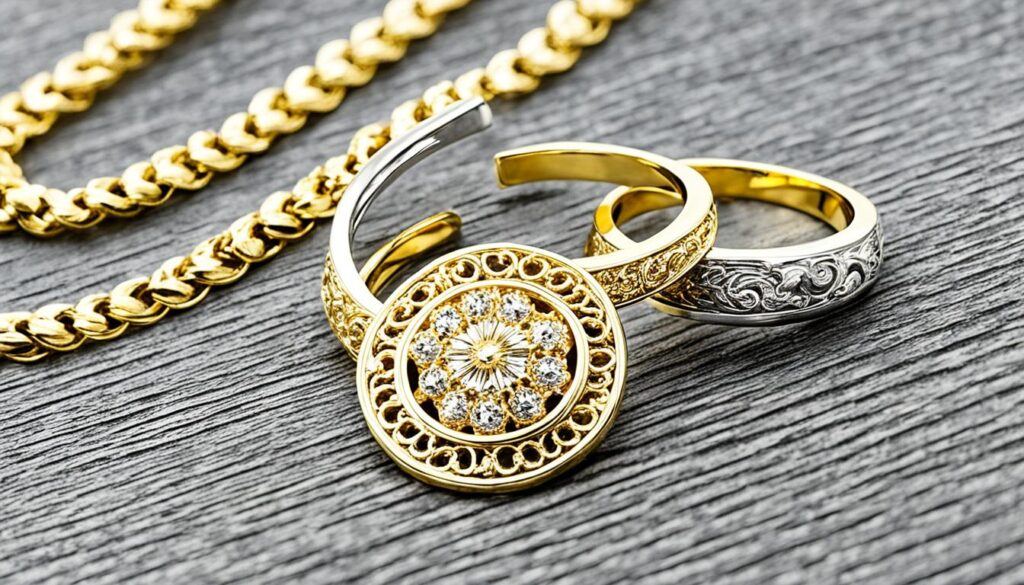
| Aspect | Gold Plated Brass | Sterling Silver |
|---|---|---|
| Base Metal | Brass | Silver |
| Durability | Less durable | Highly durable |
| Hypoallergenic | May cause allergies | Generally hypoallergenic |
| Long-term Value | Lacks long-term value | Higher value |
| Price | More affordable | Relatively affordable |
| Appearance | Mimics gold | Elegant and timeless |
| Uses | Fashion or bridge jewelry | Various styles of jewelry |
Cleaning and Maintenance
Proper cleaning and maintenance are crucial for maintaining the appearance and durability of your plated jewelry. Whether you have gold plated, silver plated, or rhodium plated jewelry, regular care will help preserve its shine and quality for years to come.
Cleaning Gold Plated Jewelry
When it comes to cleaning gold plated jewelry, a gentle approach is key. Start by creating a mild cleaning solution using a few drops of mild soap and warm water. Soak your jewelry in this solution for a few minutes, then use a soft-bristled brush or cloth to gently remove any dirt or residue. Rinse the jewelry thoroughly with clean water and pat it dry with a soft cloth. Avoid using abrasive materials or harsh chemicals, as they can damage the delicate gold plating.
Cleaning Silver Plated Jewelry
Silver plated jewelry requires a slightly different cleaning method. Instead of soap and water, use a specialized silver cleaner specifically designed for silver plated jewelry. Apply the cleaner according to the manufacturer’s instructions, using a soft cloth or brush to gently clean the jewelry. Be sure to rinse the jewelry thoroughly and dry it with a soft cloth to prevent water spots or tarnish. Avoid using abrasive materials or harsh chemicals, as they can scratch the silver plating.
Cleaning Rhodium Plated Jewelry
Rhodium plated jewelry is known for its lustrous shine and durability. To clean rhodium plated jewelry, use a soft cloth or sponge soaked in a mild detergent solution. Gently wipe the jewelry to remove any dirt or fingerprints. Rinse it thoroughly with clean water and pat it dry with a soft cloth to prevent water spots. Avoid using abrasive materials or harsh chemicals, as they can damage the rhodium plating.
Remember, regardless of the type of plated jewelry you have, it’s important to avoid exposing it to harsh chemicals, such as bleach or ammonia, as they can strip away the plating. Remove your jewelry before swimming, showering, or engaging in activities that may cause it to come into contact with chemicals or excessive moisture. By following these simple cleaning and maintenance tips, your plated jewelry will continue to sparkle and impress!
Choosing the Right Metal for Your Jewelry
When it comes to jewelry, selecting the right metal is crucial. Your choice will not only affect the overall appearance of the piece, but also its durability, value, and how it suits your personal style. Two popular options to consider are gold plated brass and sterling silver.
Factors to Consider
- Budget: Brass is generally more affordable than silver, making it a great option for those on a tight budget.
- Desired Appearance: Consider the look you’re going for. Brass can mimic the golden hue of solid gold, while sterling silver offers a sleek, silver-toned aesthetic.
- Durability: Sterling silver is known for its durability, making it less prone to wear and tear compared to brass.
- Potential Allergies: If you have sensitive skin, it’s important to consider any potential allergies. Some individuals may react to brass due to its copper and zinc content.
By considering these factors, you can make an informed decision that aligns with your preferences and requirements.
| Metal | Advantages | Disadvantages |
|---|---|---|
| Gold Plated Brass |
|
|
| Sterling Silver |
|
|
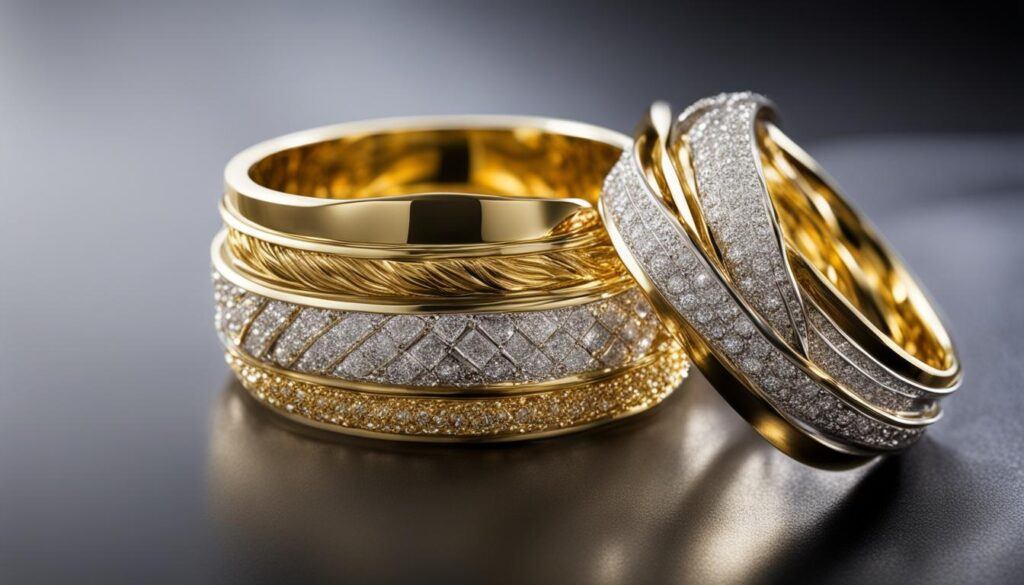
“The right metal for your jewelry is a personal choice that depends on your budget, desired appearance, and the level of durability you’re looking for.”
Consider your individual needs and preferences when making a decision. Whether you choose gold plated brass or sterling silver, both metals offer unique qualities that can enhance the beauty of your jewelry.
Conclusion
In conclusion, when it comes to choosing between gold plated brass and sterling silver for your jewelry, there are several factors to consider. Both metals have their own advantages and considerations.
Brass, with its lower price point, can provide the appearance of gold at a more affordable cost. However, it is important to note that brass may cause allergic reactions in individuals with sensitive skin. Additionally, brass lacks long-term value, and its color may fade over time.
Sterling silver, on the other hand, is a popular and durable metal in the world of jewelry making. It is often used as a base for gold plating, thanks to its value and versatility. Sterling silver jewelry holds more value than brass and is resistant to tarnish. It is considered a precious metal.
Ultimately, the choice between gold plated brass and sterling silver will depend on your budget, style preferences, and any considerations for allergies. If you are looking for a more affordable option that can mimic the appearance of gold, gold plated brass may be the choice for you. However, if you value durability and long-term value, sterling silver is the recommended option. Consider these factors carefully to make an informed decision when selecting the metal for your jewelry.
FAQ
What is the difference between gold plated brass and sterling silver?
Gold plated brass is made by applying a layer of gold over a base metal like brass, while sterling silver is a precious metal commonly used in jewelry making. Brass is more affordable but may not be hypoallergenic and lacks long-term value, whereas sterling silver is durable and holds more value.
Is brass a good material for jewelry?
Brass is a low-cost option often used in fashion or bridge jewelry because of its affordability and ability to mimic the appearance of gold. However, it may cause allergic reactions in individuals with sensitive skin and lacks long-term value.
What are the benefits of gold plated brass jewelry?
Gold plated brass is a more affordable alternative to solid gold jewelry. It can mimic the appearance of gold while being more budget-friendly. However, it may not be hypoallergenic and lacks the long-term value associated with precious metals like gold and sterling silver.
Why is sterling silver popular in jewelry making?
Sterling silver is popular in jewelry making due to its ease of use and high-shine surface. It is often used as the base metal for gold plating to enhance the value and appearance of a piece. Sterling silver is considered a precious metal and offers more durability and value compared to alloys like brass.
What are the benefits of sterling silver jewelry?
Sterling silver jewelry is durable, resistant to tarnish, and relatively affordable compared to gold. It is also a popular choice for those with sensitive skin as it is generally hypoallergenic.
What is gold plated jewelry?
Gold plated jewelry is made by applying a layer of gold over a base metal like brass or sterling silver. It is a more affordable alternative to solid gold jewelry and can vary in thickness and carat, affecting the color and quality of the piece.
What is silver plated jewelry?
Silver plated jewelry involves coating a base metal like copper or brass with a thin layer of silver. It gives the appearance of solid silver at a lower cost. The thickness of the silver layer and the base metal used can vary.
What is rhodium plated jewelry?
Rhodium plated jewelry is coated with a layer of rhodium, a rare and reflective metal. It enhances the luster and shine of the piece while protecting it from tarnishing and scratches. Rhodium plating is commonly used on sterling silver jewelry and requires less maintenance than other types of plated jewelry.
What are the differences between brass and sterling silver?
Brass is an alloy made of zinc and copper that is more affordable than sterling silver. It can mimic the appearance of gold but may cause allergic reactions and lacks long-term value. Sterling silver, on the other hand, is a precious metal with more value and durability.
What are the differences between gold plated brass and sterling silver?
Gold plated brass is a more affordable option, but it may not be hypoallergenic and lacks long-term value. Sterling silver, on the other hand, is a durable and popular metal with more value. Both metals can be plated in gold to achieve a desired look.
How should I clean gold plated jewelry?
Gold plated jewelry should be cleaned with a mild soap and warm water solution. Avoid harsh chemicals or abrasive materials that can damage the gold plating.
How should I clean silver plated jewelry?
Silver plated jewelry may require specialized silver cleaners. It is important to regularly clean and maintain silver plated jewelry to prevent tarnishing.
How should I clean rhodium plated jewelry?
Rhodium plated jewelry can be cleaned with a soft cloth and mild detergent. Avoid using abrasive materials that can damage the rhodium plating.
How do I choose the right metal for my jewelry?
When choosing the right metal for your jewelry, consider factors such as your budget, desired appearance, durability, and any potential allergies. Brass may be a more affordable option, while sterling silver offers more value and durability. Consider your personal style and preferences when selecting the right metal for your jewelry.
What should I consider when selecting jewelry metal?
When selecting jewelry metal, factors to consider include budget, desired appearance, durability, hypoallergenic properties, and value retention. It’s important to choose a metal that aligns with your style, needs, and budget.

